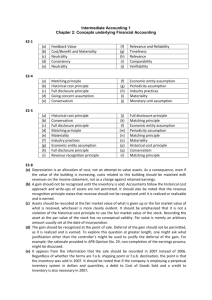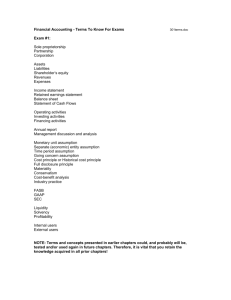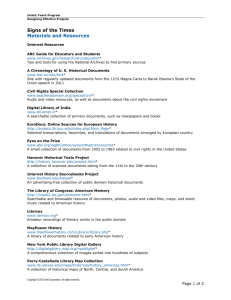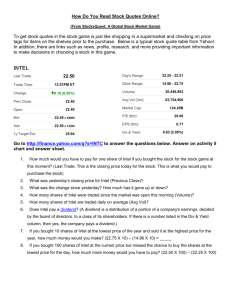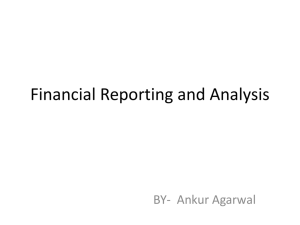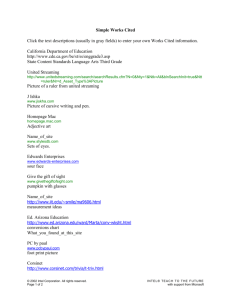Rob Oostendorp - Oostendorp.org
advertisement
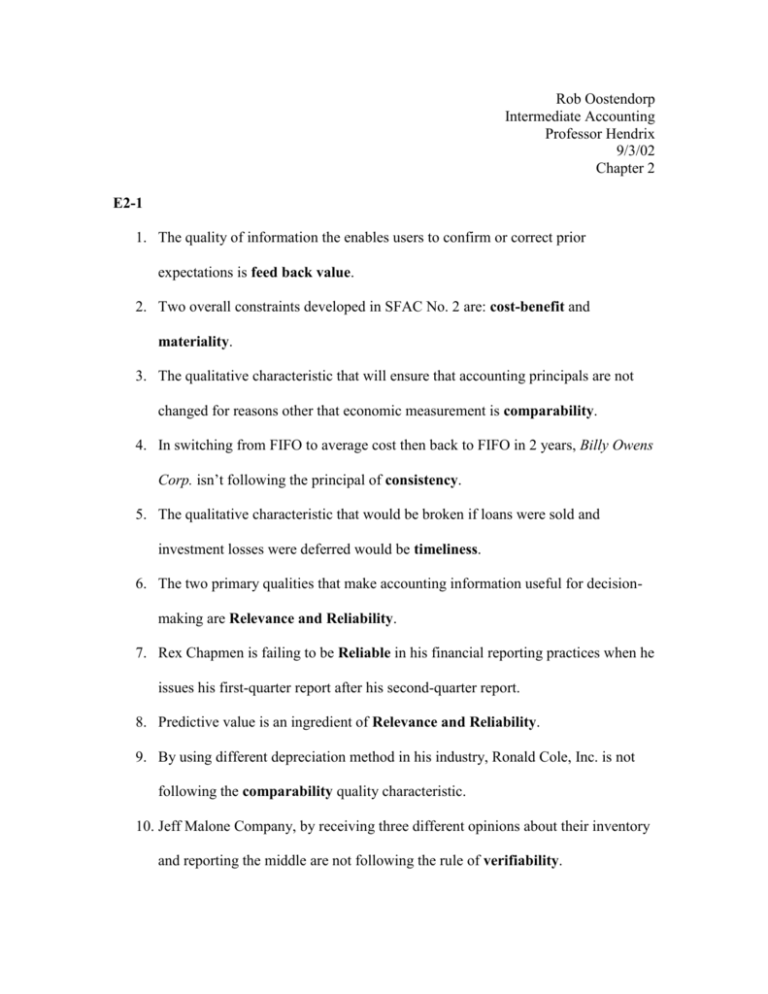
Rob Oostendorp Intermediate Accounting Professor Hendrix 9/3/02 Chapter 2 E2-1 1. The quality of information the enables users to confirm or correct prior expectations is feed back value. 2. Two overall constraints developed in SFAC No. 2 are: cost-benefit and materiality. 3. The qualitative characteristic that will ensure that accounting principals are not changed for reasons other that economic measurement is comparability. 4. In switching from FIFO to average cost then back to FIFO in 2 years, Billy Owens Corp. isn’t following the principal of consistency. 5. The qualitative characteristic that would be broken if loans were sold and investment losses were deferred would be timeliness. 6. The two primary qualities that make accounting information useful for decisionmaking are Relevance and Reliability. 7. Rex Chapmen is failing to be Reliable in his financial reporting practices when he issues his first-quarter report after his second-quarter report. 8. Predictive value is an ingredient of Relevance and Reliability. 9. By using different depreciation method in his industry, Ronald Cole, Inc. is not following the comparability quality characteristic. 10. Jeff Malone Company, by receiving three different opinions about their inventory and reporting the middle are not following the rule of verifiability. E2-4 1. Allocates expenses to revenues in the proper period. - (f) Matching principal 2. Indicates that market value changes subsequent to purchase are not recorded in the accounts. – (e) Historical cost principal 3. Ensures that all relevant financial information is reported. - (g) Full disclosure principle 4. Rationale why plant assets are not reported at liquidation value. - (b) Going concern assumption 5. Anticipates all losses, but reports no gains. – (k) Conservatism 6. Indicates that personal and business record keeping should be separately maintained. – (a) Economic entity assumption 7. Separates financial information into time periods for reporting purposes. – (d) Periodicity assumption 8. Permits the use of market value valuation in certain specific situations. - (j) Industry practices 9. Requires that information significant enough to affect the decision of reasonably informed users should be disclosed. - (i) Materiality 10. Assumes that the dollar is the “measuring stick” used to report on financial performance. – (c) Monetary unit assumption E2-6 1. With A company in the field of wine production, where a owner doesn’t want to publish a statement until a slow season comes, I would say falls under the category of industry practices 2. By issuing only price-level adjusted financial statements the company is attempting to be conservative in their practices. 3. Robert Smith Manufacturing is increasing their inventory to be able to compare themselves to the competition, they can justify this by saying the amount isn’t material. 4. By not deferring transportation costs, Flanagan’s would fall under industry practices. 5. Grab & Run believes that their job is completed once they have finished consulting their client through building and training and so by recognizing the income right away they are following the revenue recognition rule. 6. By not putting needed information about a possible take-over on financial statements, Curtis Conway Company is following the principal of going concern. 7. By charging equipment to the company account for personal use, Mike Singletary must believe that the amount is immaterial. 8. By writing all of the expenses off, Curtis Enis, Inc. was following the rule of conservatism. 9. By stating their investments at cost or market value, whichever is lower, James & Williams is following the rule of conservatism. 10. By believing that they will not have to pay a large law suit as being sued for, Big Cat Corp is following the Full Disclosure principal. FRP a. Due to frequent technological changes, Intel will have agreements with distructors allowing price protection and or/ reserve the right of return on merchandise unsold by distributors. With agreements such as this, Intel defers sales recognition until the distributor has sold the merchandise. Therefore this sort of practice falls under the conservative method. b. HC: Property Plant & Equipment is stated at Historical Cost - $11,609 million net. Inventory if value is greater than cost will be stated as cost on the Balance Sheet. FMV:Both short term debt of $159 million, and short term investments of $5272 million are displayed at fair market value. c. We can assume that we can compare Intel to itself from year to year because in the opinion of the auditor, the information is “presented fairly, in all material respects”. The auditor not only tests the data but also “includes assessing the accounting principles used and significant estimates made by management.” Intel, following GAAP, would have to include any major changes in their recording practices. d. Intel accounts for their advertising by accruing their obligations, and expensing them as the related revenues are recognized. All other advertising costs are then expensed as incurred.
